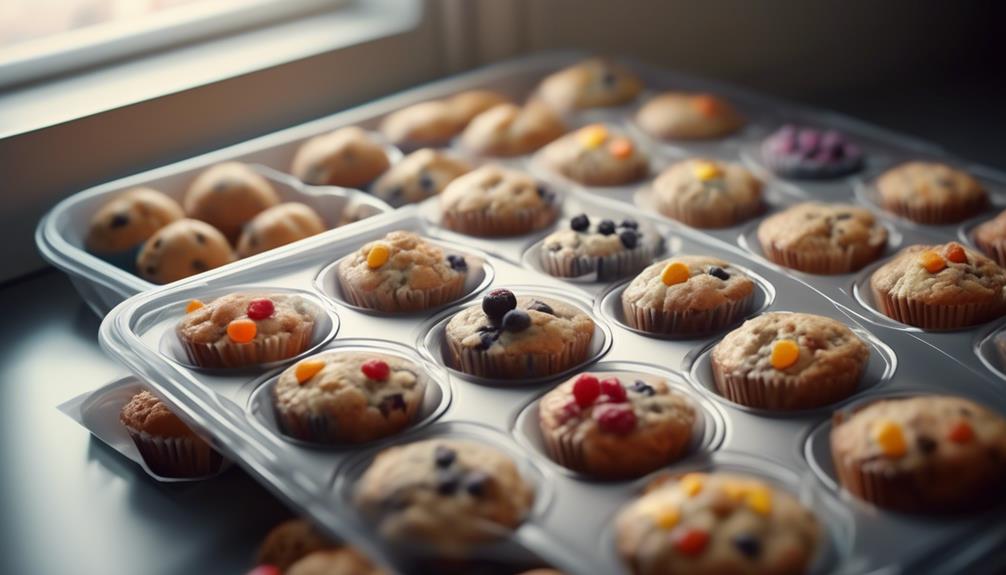Did you know that nearly 40% of food in the average American home goes to waste, often due to improper storage or preservation?
As you find yourself with a fresh batch of muffins, it's crucial to know that with the right techniques, you can extend their life significantly. You've already mastered the art of baking them to golden perfection, so let's ensure none of that effort is squandered.
When you freeze muffins correctly, you lock in their moisture and flavor, making them a delightful treat for weeks, or even months, to come. What's more, the process is simpler than you might think.
You'll want to start by selecting muffins that will withstand the freezing process well, but the key lies in the cooling and wrapping stages—where a few insider tips can make all the difference.
Let's embark on a journey to preserving your baked goods in a way that maintains that just-baked freshness, step by step, ensuring your muffins are as satisfying as the day you baked them.
Key Takeaways
- Choose moist and dense muffins with robust flavors for better freezing results
- Let muffins cool completely before freezing to prevent sogginess
- Wrap each muffin tightly with plastic wrap or aluminum foil before storing in a resealable freezer bag
- Thaw muffins at room temperature or use the microwave's defrost setting before reheating in the oven for optimal taste
Selecting the Right Muffins
When choosing muffins to freeze, look for ones with moist, dense interiors and robust flavors that'll withstand the chill. Not all muffins are created equal, and the key to ensuring your treats emerge from the freezer as delightful as when they went in lies in the muffin ingredients and batter consistency.
For starters, you'll want to use muffins that are rich in moisture-providing ingredients—think fruits like bananas or blueberries, which not only add natural sweetness but also help the muffins retain a tender crumb after thawing. Additionally, muffins with a generous amount of fat, from sources such as butter or oil, tend to freeze better, offering protection against dryness.
Pay close attention to the batter consistency before freezing. It should be thick and scoopable, not runny or overly stiff. A well-mixed batter ensures that all ingredients are evenly distributed, so each bite remains flavorful and moist, even post-freeze.
Lastly, be mindful that muffins with a high sugar content can freeze harder due to sugar's effect on the freezing point. However, they'll soften nicely at room temperature, so don't let that discourage you from wrapping up a batch of your sweetest creations.
Cooling Before Freezing
Before you tuck your muffins into the freezer, it's crucial to let them cool completely to prevent sogginess and preserve their freshly-baked quality. Rushing this step can trap steam inside the packaging, which will ultimately dampen your muffin texture, making them less enjoyable when thawed.
To ensure your muffins maintain that delightful, tender crumb, transfer them to cooling racks as soon as they're safe to handle. Cooling racks allow air to circulate around each muffin, which not only speeds up the cooling process but also prevents the bottoms from becoming soggy.
Remember, patience is a virtue, especially when it comes to preserving your baked treats. Here's a little table to remind you why it's worth the wait:
| Emotion | During Baking | While Cooling |
|---|---|---|
| Anticipation | Warm aromas | Visible steam |
| Satisfaction | Golden tops | Stable form |
| Contentment | Fresh from oven | Ready to store |
Picture yourself taking a bite of a perfectly preserved muffin, even after weeks in the freezer. By allowing them to cool properly on those racks, you're setting the stage for that future moment of pure, homely bliss.
Proper Wrapping Techniques
Ensuring your muffins are snugly wrapped will guard against freezer burn and flavor loss, keeping them as delightful as the day they were baked. The key to maintaining freshness lies in creating effective moisture barriers, which prevent the cold, dry air of your freezer from wreaking havoc on your muffins' tender crumb.
Here's a simple guide to wrapping your muffins properly:
- Cool Completely: Make sure your muffins are thoroughly cooled to avoid condensation, which can lead to sogginess.
- Wrap Individually: Use plastic wrap or aluminum foil to tightly wrap each muffin. This close contact creates a moisture barrier that locks in flavor.
- Bag Them Up: Place your wrapped muffins into a heavy-duty, resealable freezer bag. Squeeze out as much air as possible before sealing to minimize the risk of freezer burn.
- Label and Freeze: Don't forget to label your bags with the date and type of muffin. Pop them in the freezer, and you're all set!
Organizing Your Freezer
Now that your muffins are securely wrapped, it's time to consider the best way to arrange them in your freezer for easy access and optimal storage space. A well-organized freezer not only makes your life simpler but also evokes a sense of calm every time you open that frosty door. Keep track of your freezer inventory with a simple, yet heartfelt system.
Start by dividing your freezer into sections, allocating specific shelves or bins for your baked goods. This shelf arrangement will save you time and prevent any unnecessary rummaging. Here's a table to help you visualize your new freezer layout:
| Shelf/Bin | Content | Emotion |
|---|---|---|
| Top | Muffins | Joy |
| Middle | Meals | Comfort |
| Bottom | Meats | Security |
| Door | Snacks | Delight |
| Bin | Veggies | Health |
Think of your freezer as a treasure chest. Each time you reach for a muffin from the top shelf, you're indulging in a small celebration of your baking prowess. The middle shelf, stocked with ready-made meals, offers comfort on busy weeknights. The bottom shelf, with its selection of meats, provides a reassuring foundation for hearty family dinners. The door, a go-to for quick bites, brings instant delight, while the bin of veggies is a cradle of healthful eating. This thoughtful organization ensures a heartwarming experience whenever you peer inside.
Thawing and Reheating Tips
When you're ready to enjoy a muffin from your well-stocked freezer, gently thawing it to perfection is key for the best taste and texture. Here's how you can ensure your muffins are just as delightful as the day you baked them:
- Room Temperature Thawing: For the patient souls, simply place your frozen muffin on a wire rack and let it thaw at room temperature for a few hours. This slow process helps preserve the muffin texture, preventing it from becoming too soggy or dry.
- Microwave Defrosting: If you're in a hurry, use your microwave's defrost setting. Place the muffin on a microwave-safe plate and use short intervals, checking frequently to avoid overheating. This method can slightly alter the muffin's texture, so use it sparingly.
- Oven Reheating: To recapture that just-baked warmth, preheat your oven to 350°F (175°C) and warm the muffin for about 10 minutes. The gentle heat will revive the muffin without drying it out.
- Avoiding Moisture Buildup: When thawing muffins, keep them uncovered. Covering them can trap moisture and make the tops soggy. Once they're thawed, feel free to wrap them up if you're not eating them immediately.
Follow these steps, and you'll have a muffin that's as good as fresh in no time!

